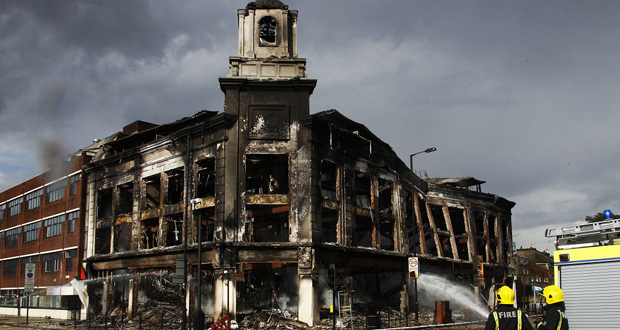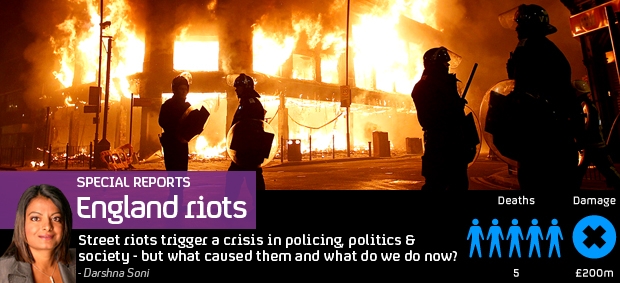The Tottenham residents burned out by the riots
A year on from the riots, parts of Tottenham remain demolished. But as policy makers and police try to fathom the anarchic violence, residents are attempting to piece their lives back together.

In the year since rioters took to the streets, shaking England to its core, the public lens has focused on the perpetrators. Almost 2,000 people were found guilty of crimes related to the violence that took place between 6 and the 10 of August.
Judges took the government’s advice and doled out severe punishment to those involved. Subsequent research has asked why such a phenomenon happened: what caused an estimated 15,000 mainly young people to inflict such violence on their neighbours and high streets in the name of branded trainers?
But Mehmet Akbasak, 31, whose Tottenham flat had to be demolished, has been preoccupied with the more practical matter of rebuilding his family home. Even a year on, he can vividly remember what happened.
“I was on the first floor. I heard loud bangs, smashing windows – it was quite horrific to be honest. I was really scared,” he told Channel 4 News. “I grabbed my wallet and car keys and left my flat. My corridor was blocked by these guys wearing masks, and they started to run towards me. I went back into my flat – I was thinking I should jump from the building.”
I heard loud bangs, smashing windows – it was quite horrific to be honest. I was really scared. Mehmet Akbasak
The initial violence erupted in Tottenham after a peaceful protest by a few hundred people over the shooting of Mark Duggan by police. Over the next four days, the violence and looting spread to east and then south London, before breaking out in Birmingham.
Mr Akbasak and his wife, Burcin (who was in Turkey at the time), lived in the River Heights flats above a Carpetright shop in Tottenham that was looted and torched by rioters on 6 August 2011. In the months that followed, the couple not only had to rebuild their home, but their means of income – Mr Akbasak is a self-employed graphic designer, and all his equipment was destroyed.
“We didn’t have any contents insurance,” he said. “It was quite horrible. No-one thinks people will come and burn down your building.” It was not until Christmas, after months spent flat-hunting while living in a temporary hotel, that Mr Akbasak could start thinking again about finding work.
“As well as all my equipment, I started making contact with my old clients again – I had lost my file with all my contact information,” he added.

The Akbasaks in their old Tottenham flat
‘Shock and anger’
The Akbasak’s housing block had 26 households, each of which had to be re-housed following the rioting. In total 55 households approached Haringey Council for support on insurance, re-housing and financing the rescue effort.
“There were two emotions that came across really clearly from traders and residents: shock and anger,” Alan Strickland, Haringey’s councillor for regeneration told Channel 4 News. “We know from the arrest statistics that most of the looters weren’t from Tottenham. Most people in Tottenham stayed at home that night, watching it unfold in horror on their TV like the rest of the country.”
But, as was noted at the time, the anti-social behaviour was soon met with a rallying community spirit, and neighbours and businesses raised more than £50,000 which was given out in grants to those affected. Lord Harris, chairman of Carpetright at the time, told Channel 4 News he had met all of those left homeless and promised money to help them through the initial month.
Building begins – one year on
One year on, almost to the day of the anniversary, the rebuild of the 1930s art deco building will begin. Metropolitan Housing Partnership (MHP) has planned a more sustainable and improved building, but one which retains the iconic front façade [see CGI image below]. 13 of the original 26 households are returning when the build is complete – hopefully by October next year.
“Some residents were able to move in with family and friends, some needed to ensure accommodation through the local authority,” Jon Maxwell, MHP’s southern regional director, told Channel 4 News. “For some people, waiting until next October is too long.”
I continue to meet businesses still waiting for pay-outs, facing a backlog of bureaucracy. That’s incredibly difficult if you’re a small family business. Alan Strickland, Haringey councillor
The flats were leased under a shared ownership scheme, so residents owned a percentage of their flats – some 100 per cent – and rented the remainder. “Those who have chosen not to move back into the building, Metropolitan has purchased those properties back from them,” said Mr Maxwell. “We’ve made sure that residents’ financial situation should be neutral.”
Other business have not been so lucky. Tottenham MP David Lammy has expressed concerms that some companies have been penalised by a punitive rise in insurance premiums and a long wait for compensation.
“Thankfully a lot of businesses have moved on,” said Cllr Strickland. “They’ve rebuilt, had financial support, but I continue to meet businesses still waiting for pay-outs, facing a backlog of bureaucracy. That’s incredibly difficult if you’re a small family business.”

I Love Tottenham
Haringey Council has since put together a plan for regenerating the area, focused on three main priorities: restoring the area’s businesses (with a £2m recovery package), “rebuilding confidence”, and ensuring rebuilding is sustainable long-term. One of the most visible results of the scheme has been the I Love Tottenham campaign which was adopted by local traders, residents and schools. The Duchess of Cornwall was even seen sporting a badge on a visit to the area in July.
For Mehmet and Bercin Akbasak, they are finally starting to look to the future. Mrs Akbasak is three months pregnant and Mehmet has resumed training for a pilot license after being forced to stop after the riots.
“I still don’t blame Tottenham. Because the first couple of weeks, we were thinking we wouldn’t go back, but now we start to miss our old place,” he said. “We had nice neighbours and the flat was really nice. We had meetings with Met police – they will try their best that it won’t happen again.”
The Olympics has been a source of positive community spirit – the kind shown in the robust, determined clean-up operation immediately after the riots, adds Cllr Strickland, who reflects the thoughts of the community in his hopes for Tottenham’s future.
“At the Olympic torch relay, the pavements were 10-deep with people,” he told Channel 4 News. “The hugely diverse community were out for hours, with people dancing with police in the streets – it’s a really strong harmonic community. I think that’s the real face of the community in Tottenham.”





